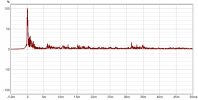I've been looking to (and working on) improve the stereo setup in my new place for a while now; Mainly moving the speakers around, applying EQ (on a miniDSP-like setup), and recently (making quite a large impact) moving aside my large oak coffee table. The current setup is quite basic:

On the left is open space for ~5 meters, on the right is a hard wall / window with curtains, and behind the couch I'm sitting there's about 1 meter of space before the back wall. There's no room treatment besides a 200 cubic feet foam bean bag against that wall. The current (MMM) frequency response over the 3 seater sofa (with EQ) looks like this:

I'm still not quite happy with the sound as it is - I've heard many better systems, but am not really sure on what to improve from this point onward. I've been looking at step responses and impulse responses, but can't quite find information on what these should look like and how (significantly) that influences the sound. The same goes for waterfall graphs and spectrograms.
Room treatment wise I read that rugs are heavily recommended, thick absorption behind the speakers 'helps', ceiling treatment is good, side reflections can kinda stay, and generally filling your walls with panels helps dampening the room - but - I find it hard to link those improvements to actual measurements (and thus keep track of whether it's objectively helping).
Could some of you provide some guidance on these time / frequency domain measurements translate to perceived sound? I'd love to be able to work towards measurable goals in treating the room / perhaps purchasing new speakers / bi-amping these to time align the drivers (if that does anything significant). I've included my REW measurements of the room as it is.
Many thanks!
- David
Appendix pictures:



On the left is open space for ~5 meters, on the right is a hard wall / window with curtains, and behind the couch I'm sitting there's about 1 meter of space before the back wall. There's no room treatment besides a 200 cubic feet foam bean bag against that wall. The current (MMM) frequency response over the 3 seater sofa (with EQ) looks like this:
I'm still not quite happy with the sound as it is - I've heard many better systems, but am not really sure on what to improve from this point onward. I've been looking at step responses and impulse responses, but can't quite find information on what these should look like and how (significantly) that influences the sound. The same goes for waterfall graphs and spectrograms.
Room treatment wise I read that rugs are heavily recommended, thick absorption behind the speakers 'helps', ceiling treatment is good, side reflections can kinda stay, and generally filling your walls with panels helps dampening the room - but - I find it hard to link those improvements to actual measurements (and thus keep track of whether it's objectively helping).
Could some of you provide some guidance on these time / frequency domain measurements translate to perceived sound? I'd love to be able to work towards measurable goals in treating the room / perhaps purchasing new speakers / bi-amping these to time align the drivers (if that does anything significant). I've included my REW measurements of the room as it is.
Many thanks!
- David
Appendix pictures:

